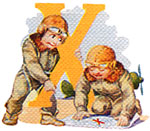EDITOR'S
NOTES
Looking
back to a school at war
Four
Septembers ago, browsing in O'Gara & Wilson's, I found a well-used
children's alphabet book. Its cover was missing but at the bottom
of the first page were the publisher's name (Samuel Lowe Company)
and copyright date (1943). I knew I was going to buy it. How could
I not buy an abecedary that matched brightly colored letters with
now arcane professions-…G for Glass blower, H for Hackman,
I for Iceman, J for Junkman…? When I turned the pages, the
quaintness continued, this time in an architecture alphabet (…M
for Movie house, N for Natural history museum…).
 But
the alphabet that stood out was one inspired by 1943's all-consuming
experience, World War II. Cherub-faced soldiers marched across
the page…I for Infantry, J for Jeep, K for Kitchen police….
That war alphabet seemed one more artifact from a gone-forever
time, like the WW II savings bond posters and patriotic songbook
(New Songs for Schools at War) that we found in my mother's
save-everything-files after her death.
But
the alphabet that stood out was one inspired by 1943's all-consuming
experience, World War II. Cherub-faced soldiers marched across
the page…I for Infantry, J for Jeep, K for Kitchen police….
That war alphabet seemed one more artifact from a gone-forever
time, like the WW II savings bond posters and patriotic songbook
(New Songs for Schools at War) that we found in my mother's
save-everything-files after her death.
This
September I decided to go back to another publication from the
1940s, the December 1941 issue of the University of Chicago Magazine.
I wanted to see how the campus had reacted to, and what the editors
had written about, the only other time the United States had been
attacked on its home soil. Thumbing through the maroon-bound volume
for 1941-42, I stopped for a while at the November 1941 number.
That "Fiftieth Anniversary Celebration Issue" recorded
the events of September 22-29, when Chicago marked its birthday
with academic symposia, an SRO convocation in Rockefeller Chapel,
a re-creation of the Columbian Exposition's Midway (complete with
a reincarnation of its famous dancer, Little Egypt), and a special
University broadcast of the Chicago Round Table.
From
that celebration I moved on to the December issue. There the lead
story in the "News of the Quadrangles" section was "The
University at War." It was a first indication of how life
had changed. "Even the new paper stock on which you read
these words is keyed to the war," the editors noted. "Chlorine,
which bleaches paper, is restricted these days."
The
"News of the Classes" began with news of those "In
the Service," from Byron E. Bassham, MD'41, an assistant
surgeon in the U.S. Naval Hospital in Hawaii, to Herman Schneiderman,
PhD'39, "on active duty as a second lieutenant in the Air
Corps Reserve at Bellows Field, Waimanalo, Oahu, Hawaii, where
he serves as an assistant photographic officer." A full-page
ad urged recent grads to join the Civil Service, and "Chicago
in Washington" presented "an informal report, with sidelights,
on younger alumni in the war capital." Included were Philip
Coombs, AM'39, in the Office of Price Administration (who figured
out what to do with the non-aluminum metals that patriotic citizens
had mistakenly gathered in a national aluminum collection campaign)
and Hart Perry, AM'40, in the Division of Defense Housing Coordination,
an office charged with deciding "between private or public
construction of war workers' homes from Bangor to Bellingham."
If
those details also sound quaint, other concerns remain current.
One draft-age student worried in print, "Your paper for Paleography
201 doesn't seem so significant if you know that you might never
live to take 202….for anyone sitting down now and thinking
out his future for the next twenty years, no sir. Too many fogs
ahead."
And
President Robert M. Hutchins told a packed Mandel Hall, "Now
that we are at war we must proceed to win the war as quickly as
possible." Hutchins nevertheless argued that the University
must go on as it always had-teaching, learning, and creating knowledge-for
the nation's sake: "If our institutions have to be sacrificed
to win the war, then I am in favor of sacrificing them. But if
some can be saved, then I should hope that the educational system
might be one of them, for through the educational system all the
rest might be born again."- M.R.Y.

![]()
 But
the alphabet that stood out was one inspired by 1943's all-consuming
experience, World War II. Cherub-faced soldiers marched across
the page…I for Infantry, J for Jeep, K for Kitchen police….
That war alphabet seemed one more artifact from a gone-forever
time, like the WW II savings bond posters and patriotic songbook
(New Songs for Schools at War) that we found in my mother's
save-everything-files after her death.
But
the alphabet that stood out was one inspired by 1943's all-consuming
experience, World War II. Cherub-faced soldiers marched across
the page…I for Infantry, J for Jeep, K for Kitchen police….
That war alphabet seemed one more artifact from a gone-forever
time, like the WW II savings bond posters and patriotic songbook
(New Songs for Schools at War) that we found in my mother's
save-everything-files after her death.